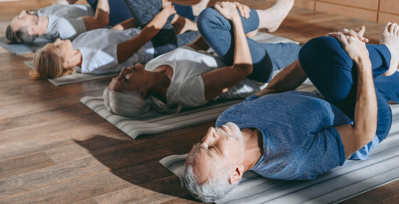Last updated on July 12th, 2024 at 11:17 am
Regular physical activity improves health, fitness, and quality of life for adults and children. The physicality of work requirements on farms and ranches takes a toll on overall body conditioning and wellness. By engaging in regular aerobic and muscle strengthening activities, individuals can maintain a healthy weight, improve heart health, strengthen bones and muscles, improve sleep quality, maintain normal blood pressure, and reduce stress.
Stretching regularly increases flexibility and is an important factor of fitness. It also improves posture, reduces stress, and relieves/lessens body aches. With help from Yoga and Pilates certified instructors, AgriSafe has developed a Ready to Farm campaign of posters and videos to develop strength, flexibility, balance, and conditioning of commonly used muscles in farm and ranch work.
Adults should aim for 2 ½ hours per week or about 30 minutes a day for 5 days a week of moderate-intensity to vigorous-intensity aerobic activity. Brisk walking, pushing a lawn mower, and riding a bike are moderate-intensity activities. Moderate-intensity activity means you are working hard enough to raise your heart rate and break a sweat; you should be able to talk but not sing. Vigorous-intensity aerobic activity includes jogging or running for 75 minutes, swimming laps, riding a bike fast and playing basketball. In vigorous level activities you will not be able to say more than a few words without pausing for a breath.
A mix of moderate-intensity and vigorous-intensity is acceptable. If you have not been active lately, increase your physical activity level slowly. If you have a history of chronic disease, check with your doctor before engaging in vigorous-intensity activity.
Muscle-strengthening activities including lifting weights, using your body weight for resistance such as sit-ups, push-ups, working with resistance bands, heavy gardening and some forms of yoga. In addition to aerobic exercises, you should practice muscle-strengthening activities at least 2 days a week. Muscle-strengthening activities work all major muscle groups including legs, hips, back, abdomen, chest, shoulders, and arms. To improve health-aerobic activity and muscle strengthening do two types of physical activity each week. Finding a balance that works for you is key. Spreading out your activity in smaller chunks of time during the week is beneficial and may be more suitable to your schedule.
Long-term benefits of exercise include:
- Brain Health – it reduces risks of developing dementia (including Alzheimer’s disease) and reduces risk of depression
- Heart Health – it lowers risk of heart disease, stroke, and type 2 diabetes
- Cancer Prevention – it lowers risk of eight cancers: bladder, breast, colon, endometrium, esophagus, kidney, lung, and stomach
- Healthy Weight – it reduces risk of weight gain
- Bone Strength – it improves bone health
- Balance and Coordination – it reduces risks of falls
Exercise Resources
Fact Sheets
Page updated: August 2022




